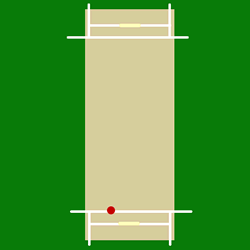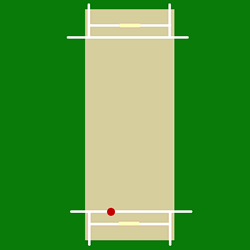
Leg spin is a type of spin bowling in cricket. A leg spinner bowls right-arm with a wrist spin action. The leg spinner's normal delivery causes the ball to spin from right to left when the ball bounces on the pitch. For a right-handed batter, that is away from the leg side, and this is where it gets the name leg break.
The flipper is a particular bowling delivery used in cricket, generally by a leg spin bowler. In essence it is a back spin ball. Squeezed out of the front of the hand with the thumb and first and second fingers, it keeps deceptively low after pitching and can accordingly be very difficult to play. The flipper is comparable to a riseball in fast-pitch softball.

Off spin is a type of finger spin bowling in cricket. A bowler who uses this technique is called an off spinner. Off spinners are right-handed spin bowlers who use their fingers to spin the ball. Their normal delivery is an off break, which spins from left to right when the ball bounces on the pitch. For a right-handed batsman, this is from his off side to the leg side. The ball breaks away from the off side, hence the name 'off break'.
In the game of cricket, a googly refers to a type of delivery bowled by a right-arm leg spin bowler. It is different from the normal delivery for a leg-spin bowler in that it is turning the other way. The googly is not a variation of the typical off spin type of delivery, in that the cricket ball is presented from the bowler's hand in such a way that once the ball pitches; instead, it deviates in the opposite direction of a leg spinning type of delivery. It has also been colloquially referred to as the wrong'un, Bosie or Bosey, with the latter two eponyms referring to Bernard Bosanquet, the bowler who originally devised and began using the googly.

The fastball is the most common type of pitch thrown by pitchers in baseball and softball. "Power pitchers," such as former American major leaguers Nolan Ryan and Roger Clemens, rely on speed to prevent the ball from being hit and throw fastballs at speeds of 95–105 miles per hour (153–169 km/h) (officially) and up to 108.1 miles per hour (174.0 km/h) (unofficially). Pitchers who throw more slowly can put movement on the ball, or throw it on the outside of home plate where batters cannot easily reach it.

Spin bowling is a bowling technique in cricket, in which the ball is delivered relatively slowly but with the potential to deviate sharply after bouncing. The bowler is referred to as a spinner.
In the sport of cricket there are two broad categories of bowlers: pace and spin. Pace bowlers rely mostly on the speed of the ball to dismiss batsmen, whereas spin bowlers rely on the rotation and turn of the ball.
In the sport of cricket, a slower ball is a slower-than-usual delivery from a fast bowler. The bowler's intention is to deceive the batsman into playing too early so that he either misses the ball completely or hits it high up in the air to offer an easy catch. It is analogous to a changeup in baseball.
Wrist spin is a type of bowling in the sport of cricket. It refers to the cricket technique and specific hand movements associated with imparting a particular direction of spin to the cricket ball. The other spinning technique, usually used to spin the ball in the opposite direction, is finger spin. Wrist spin is bowled by releasing the ball from the back of the hand, so that it passes over the little finger. Done by a right-handed bowler, this imparts an anticlockwise rotation to the ball, as seen from the bowler's perspective; a left-handed wrist spinner rotates the ball clockwise.
Finger spin is a type of bowling in the sport of cricket. It refers to the cricket technique and specific hand movements associated with imparting a particular direction of spin to the cricket ball. The other spinning technique, generally used to spin the ball in the opposite direction, is wrist spin. Although there are exceptions, finger spinners generally turn the ball less than wrist spinners. However, because the technique is simpler and easier to master, finger spinners tend to be more accurate.

The tailwhip is a bike trick typically performed on a BMX, in which the frame of the bike performs a complete rotation around the front end, which remains stationary throughout the move. The same trick may also be performed on a kick scooter.
Table tennis is unique among racket sports in that it supports a wide variety of playing styles and methods of gripping the racket, at even the highest levels of play. This article describes some of the most common table tennis grips and playing styles seen in competitive play. The playing styles listed in this article are broad categories with fuzzy boundaries, and most players will possess some combination of these styles while leaning towards a "favorite". Many advanced players will also add some "special" shots of their own.

A fire fan is a fan shaped object usually constructed of non-combustible materials such as welded metal and Kevlar wick that is set alight. They are used for fire performance.

In ball sports, topspin or overspin is a property of a ball that rotates forwards as it is moving. Topspin on a ball propelled through the air imparts a downward force that causes the ball to drop, due to its interaction with the air. Topspin is the opposite of backspin.

A hand wrap or wrist wrap is a strip of cloth used by boxers to protect the hand and wrist against injuries induced by punching. It is wrapped securely around the wrist, the palm, and the base of the thumb, where it serves to both maintain the alignment of the joints, and to compress and lend strength to the soft tissues of the hand during the impact of a punch.
In cricket, a slider is a type of delivery bowled by a wrist spin bowler. While a topspinner is released with the thumb facing the batter, a slider is bowled in a similar manner to a legbreak, but instead of imparting sidespin with the third finger, the bowler allows his fingers to roll down the back of the ball, providing a mixture of sidespin and backspin. Whereas a topspinner tends to dip more quickly and bounce higher than a normal delivery, a slider does the opposite: it carries to a fuller length and bounces less than the batter might expect. The sliders will typically head towards the batter with a scrambled seam. This has less effect on the flight and bounce but absence of leg spin may deceive the batter. Frequently the slider is bowled with a mixture of side spin and backspin. This has the effect of making the ball harder to differentiate from the leg break for the batters without reducing the mechanical effects caused by the backspin. This delivery may skid straight on or it may turn a small amount.
Coin manipulation is the art of manipulating coins in skillful flourishes, usually on or around the hands. Although not always considered coin magic, the tricks are sometimes used in magic shows. The difficulty of the trick ranges greatly, from some that take a few minutes to accomplish, to much more complex ones that can take months, even years, to master. One of the best-known tricks is the relatively advanced coin walk.

Twirling is a form of object manipulation where an object is twirled by one or two hands, the fingers or by other parts of the body. Twirling practice manipulates the object in circular or near circular patterns. It can also be done indirectly by the use of another object or objects as in the case of devil stick manipulation where handsticks are used. Twirling is performed as a hobby, sport, exercise or performance.
In the sport of ten-pin bowling, there are many different ways in which to deliver the bowling ball in order to advance it toward the pins in an accurate and powerful manner. Generally, there are three basic forms of 10-pin bowling. The most basic form is known as stroking, which is the most classic form. The most powerful form is known as cranking, which imparts great leverage and maximum rotation on the ball, but sacrifices accuracy. In between the two is the domain of the tweener, who has characteristics of both, but does not truly fit into either category. A well-known variant of "tweening" is the power stroker.
Poi tricks are defined by the manipulation and combination of several variables of the spinning activity. These variables typically include, but are not limited to, the following:
















